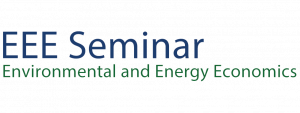Sam Kortum
 Yale University
Yale University
Homepage
“Optimal Unilateral Carbon Policy”
Abstract: We consider climate policy by one country in a world with international trade in energy and in manufactured goods produced with energy and labor. Assuming that the country’s trading partner is passive, we derive an optimal unilateral policy to confront the global externality from manufacturing’s combustion of carbon-based energy. Our solution strategy combines techniques from Markusen (1975) and from Costinot, Donaldson, Vogel, and Werning (2015). We interpret the optimal policy as a particular set of taxes and subsidies. The key features are: (i) the country institutes a carbon tax equal to its damages from emissions, raising the cost of energy for its manufacturers relative to the price received by its energy extractors; (ii) this Pigouvian tax is the sum of an extraction tax and a production tax on the use of energy, with a border adjustment on imports equal to the production tax; (iii) the mix between the extraction and production tax is optimized to reduce carbon leakage and to improve the country’s terms of trade; (iv) the border adjustment on the energy content of imported manufactured goods leaves the country’s consumption decisions undistorted; (v) energy taxes are not removed at the border for exports, but instead the country subsidizes exports of goods in which its comparative advantage is weak while taxing those where its comparative advantage is strong; (vi) the country expands exports of manufactures on the extensive margin, potentially even exporting goods that it also imports. Features (i)-(iii) of this optimal policy are reminiscent of Markusen, in a model with trade only in energy. Features (iv)-(v) are reminiscent of Costinot et al., in a model with no externalities. A novel property, captured in (vi), is how the country can exploit international trade in manufactured goods to expand the reach of its climate policy. Through its tax policy the country indirectly controls how energy is used in producing both its imports and its exports.
This seminar will be online. Zoom details will be provided a couple of days prior.


 Yale University
Yale University University of Illinois at Urbana-Champaign
University of Illinois at Urbana-Champaign
 UC Santa Barbara
UC Santa Barbara University of Chicago
University of Chicago Columbia Business School
Columbia Business School UC San Diego
UC San Diego Cornell University
Cornell University MIT Sloan
MIT Sloan